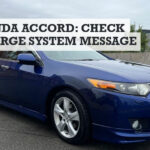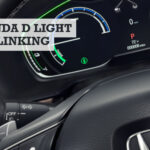Finding out that you have a dead or dying battery will always happen at the most inconvenient time when you just needed to get somewhere fast. You will have heard that you can start revving the engine to charge battery faster, but just how true is this?
Here’s the short answer first, followed by more detail regards what people say about the damage from revving an engine in park or neutral.
Does revving the engine charge the battery? Yes, revving the engine can charge your battery faster, but only when the battery is nearly dead and close to being depleted of power. Revving will accelerate the crankshaft’s rotation, so in theory speeds up the rate of energy conversion to the battery.
There’s more to it than that though, and some warnings below on how long you should rev the engine to charge your battery.
Revving your car’s engine to charge the battery
A car’s charging system ensures the battery always has a suitable power supply providing you keep the car on the road and drive it regularly. Because of that, revving your engine when you get into the car isn’t going to have an effect.
However, in cases where the battery is dead or nearly depleted, you might find you can charge it quicker by revving the engine. I’ve read a note from a mechanic who recommends you keep the revs between 1,500 and 2,500 RPM.
There is some theory behind this though. I saw this statement on a Reddit thread when someone asked whether revving the engine charge the battery faster:
“When a car is running, the engine crankshaft is in motion. A belt goes from the engine crankshaft to a pulley attached directly to the alternator, which converts the mechanical energy from the crankshaft spinning into electrical energy to recharge the car battery. Since revving your engine (even in neutral) accelerates the engine crankshaft’s rotation, this increases the rate of mechanical energy conversion into electrical energy and should in theory charge the battery faster.”
That makes a lot of sense to me.
Revolutions of the alternator are directly proportional to the engine’s revolutions, meaning the faster the engine turns, the more electricity the alternator produces. With a dead battery running the car at idle speed, it will take forever to charge it if the alternator manages to charge it at all.
Keep in mind that revving your engine to charge the battery while the car is not moving isn’t healthy for the engine, so make sure not to go over 2,500 RPM.
Handy Hint: I analyzed the top speeds of the modern Honda Civics to see which once can go the fastest 0 to 60 mph.
How long to rev engine to charge battery?
From what I can gather, it’s not recommended that you rev the engine to charge the batter any longer than for 5 minutes.
Once your car gets moving, it’s preferable that you drive for between 20 and 30 minutes to get the battery charged up quicker.
When to rev the engine to charge the battery
Here are the specific scenarios in which it’s beneficial to rev your engine to charge the battery.
The most common reason for a dead battery is when starting your car for the first time in the morning. This problem can arise when an old battery meets cold weather, or it just means that you forgot to turn something off the night before, such as the lights or the radio.
Here is what you can do to get your car going.
Does revving your engine help jump battery or jump-start another car?
Suppose you turn your key to the on position and see no dashboard lights. In that case, it means your battery is almost at a 0% charge and trying to push start probably won’t work.
Jumper cables are your safest bet in a scenario like this. Once you connect your battery with another car, revving the donor car will significantly increase the charging rate of your dead battery.
Again, make sure you keep it under 2,500 RPM. After a couple of minutes, your car should be able to start depending on the size difference between the two vehicles. After you start your car, you should keep your car’s RPM above idle speed for about 5 minutes, and after you take it for a short drive, the battery could be back to enough power.
Push starting a car with a dead battery
In a case where your battery still has some charge but not enough to turn the engine over, you can try and push start it, but only if your manufacturer allows that.
Push starting a car might void the warranty in some vehicles and cause potential damage. Each car is different on this matter, so make sure to check that for your specific engine and model.
After you start your car this way, you can take it for a short drive right away, or you could rev the engine while the vehicle is standing still. Still, taking it for a short drive is much healthier since that won’t be a problem in this case.
Book an electrical diagnosis if you get regular dead batteries
Suppose you wake up to a dead battery regularly, every morning or a couple of times a week, and you are sure you turned all the auxiliaries off.
In that case, there is most probably a faulty electronic component that keeps draining your battery even when the car is off. A thorough electrical diagnosis will help you find the culprit.
On the other hand, a faulty alternator will be easy to notice since your car will lose electricity while driving and ultimately stop. It could also happen that your car works fine while connected to another running vehicle but dies after it’s disconnected.
If you find yourself in some scenarios where revving the engine is beneficial, ensure you keep to the mentioned instructions. Not adhering to them can cause many problems since a car isn’t designed to stand still while running for prolonged periods, especially not running above idle speed.
Issues that can arise are overheating, and an engine not getting sufficient lubrication, both of which can cause catastrophic damage.
Battery problems aren’t limited to not having enough electricity. A battery can also be overcharged, which is much more harmful than being depleted of power. Here are some symptoms to look out for if you suspect this might be a problem with your car.
- Burning wires, smell, or smoke.
- The smell of sulfuric acid.
- Interior lights are noticeably brighter than usual.
- Whining noises that increase with engine revs.
- Battery warning light.
The cause of overcharging is always the alternator, but it doesn’t mean you need to replace the whole unit. All alternators have an integrated voltage regulator that limits or increases the power going to the battery.
If you notice these symptoms, the voltage regulator is often the culprit. It will be a lot cheaper to repair than replace the alternator.
Does revving the engine help jump-start another car?
Revving the car that is trying to jump-start another does help. Make sure not to floor the throttle, but a light input keeping the car roughly 1,000 RPM above idle will do the trick just fine.
Does revving the engine make the car warm up faster?
Based on what we now know, revving the engine can help make the car warm up faster if the battery is low on power. The better solution is to get driving, as once the wheels start turning, after 20 minutes, your battery will be very well powered again.
How long should I idle my car to charge the battery?
Keeping your car at idle speed to charge the battery will take around 15 minutes on average, but I don’t recommend that. Slightly revving your car for a couple of minutes and taking it for a short drive after letting it idle is a much safer way to do it.
You can read all the pros and cons of battery charging by idling here.
Does revving the engine in park damage it?
It doesn’t have to if you keep the RPM not much above idle speed and don’t do it for longer than 5 minutes. Anything more than this can substantially damage your engine.
Conclusion
A dying battery will typically happens when you wake up one morning and just want to get going. Thankfully it might be relatively simple to solve if you can still rev the engine a little to get some charge into the battery.
More simple car guides…
Image in header via https://pixabay.com/photos/car-driving-gas-brake-clutch-824074/






